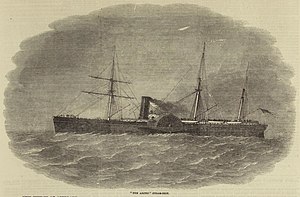
Back Arctic (Schiff, 1850) German اساس آرکتیک Persian SS Arctic Finnish SS Arctic French Arctic (schip, 1850) Dutch Арктик (колёсный пароход) Russian
 The Arctic by Edwin Weedon for The Illustrated London News
| |
| History | |
|---|---|
| Name | Arctic |
| Namesake | Arctic |
| Owner | Collins Line |
| Operator | Captain James C. Luce |
| Builder | William H Brown Shipyard - New York |
| Launched | January 28, 1850 |
| Completed | 1850 |
| Maiden voyage | October 26, 1850 |
| Out of service | September 27, 1854 |
| Fate | Sank on September 27, 1854 after collision with SS Vesta |
| General characteristics | |
| Tons burthen | 2,856 American tons burthen |
| Length | 284 feet (87 m) |
| Beam | 45 feet (14 m) |
| Draught | 19 feet (5.8 m) |
| Depth | 32 feet (9.8 m) |
| Installed power | 2,000 hp (1,500 kW) |
| Propulsion | two side-lever steam engines |
| Capacity | Passengers: 200 1st class, 80 2nd class |
| Crew | 153 |
SS Arctic was a 2,856-ton paddle steamer, one of the Collins Line, which operated a transatlantic passenger and mail steamship service during the 1850s. She was the largest of a fleet of four, built with the aid of U.S. government subsidies to challenge the transatlantic supremacy of the British-backed Cunard Line. During her four-year period of service, the ship was renowned both for her speed and for the luxury of her accommodation.
On September 27, 1854, while on passage to New York from Liverpool, Arctic collided in fog with the French steamer SS Vesta off the coast of Newfoundland, and sank four hours later. Arctic's lifeboat capacity was around 180, enough for fewer than half those on board; the boats were launched in an atmosphere of panic and disorder, and the principle of "women and children first" was ignored. From around 400 on board (250 passengers, 150 crew), 24 male passengers and 61 crew survived; all the women and children died. No one was called to account for the disaster, and no official enquiry was held. Lifeboat provision on passenger-carrying ships remained inadequate until well into the 20th century.
© MMXXIII Rich X Search. We shall prevail. All rights reserved. Rich X Search